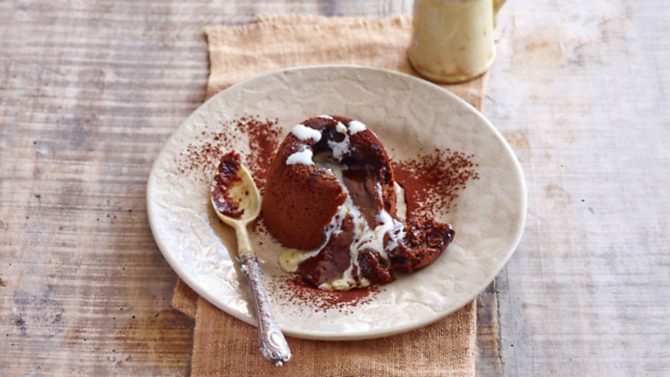Recipe: Fondant au chocolat

Indulge your sweet tooth and impress your guests with our recipe for fondant au chocolat and find out how the dessert was invented
Written by Louise Pickford
This little chocolate pudding, half cake, half molten chocolate volcano, is not to be confused with the rich flourless chocolate cake (known as a gâteau fondant au chocolat) that shares the same name on many menus. Word has it that Jean-Georges Vongerichten, a French chef working in the US, accidently created a fondant au chocolat when he mistakenly removed the cake he was baking from the oven too soon, and when he cut into the centre, a gooey chocolate sauce flowed out. As the mixture was warm with an inviting glossy texture, a new dessert was born – or was it? Another French chef, Jacques Torres – a chocolatier, to boot – disputed the originality, exclaiming that such a cake already existed in France.
The proof maybe inconclusive, but this little pudding still has every right to be served in restaurants, not only in the States and France, but on menus worldwide; for if the proof is in the pudding, then this is it. Baked in small dariole moulds also known as timbales (small pudding-shaped cylindrical moulds), the sponge is light and delicate, while the sauce is as unctuous, rich and delicious as a chocolate sauce can be. The five basic ingredients are chocolate, eggs, butter, flour and sugar, but the recipe can be adapted to include caramel in the centre as this one does, or perhaps a square of chilli, or other flavoured, chocolate. It can be served with cream, ice cream, crème fraîche, or even fresh raspberries, and is almost always dusted with a fine coating of cocoa powder before being brought to the table.
It is a surprisingly simple dish to make, and is ideal for a dinner party. The number of impressed exclamations from guests will be reward enough, but there are a few vital rules to ensure success. You really do need to buy the correct moulds, which are readily available in cookware stores, and they must be of a 150ml capacity. Prepare the insides of the moulds well, and chill for 10 minutes before filling. Make sure your oven runs at the correct temperature; an oven thermometer is cheap and invaluable if you’re a keen baker. Timings too are vital; cook for 13 minutes precisely, then leave to sit for a further 5 minutes – turning them out should be a breeze if you follow this to the letter.
RECIPE
Serves 4
INGREDIENTS
• 100g unsalted butter, plus extra for greasing the moulds
• 100g dark chocolate
• 2 eggs, plus 2 egg yolks
• 1 tsp vanilla essence
• 125g caster sugar
• 100g plain flour, plus extra for dusting the moulds
• 4 tsp salted caramel sauce
• cocoa powder, to dust
• double cream, to serve
METHOD
1. Preheat the oven to 180°C/fan 160°C/Gas 4. Brush the insides of four 150ml metal dariole moulds with melted butter, dust lightly with flour, then chill for 10 minutes. Arrange the moulds on a baking tray.
2. Meanwhile, heat the butter and chocolate together in a bowl set over a pan of just simmering water (don’t let the base of the bowl touch the water). Stir until melted and then remove from the heat. Put the bowl to one side and leave to cool for 5 minutes.
3. Beat the eggs, egg yolks, vanilla essence and sugar in a separate bowl, using an electric whisk, for 3-4 minutes until thick and fluffy. Sift in the flour and fold in carefully, followed by the chocolate mixture, until smooth.
4. Spoon half the mix into the moulds, add 1 teaspoon of salted caramel sauce to the middle of each one. Cover with the remaining chocolate mixture, to about 5mm from the top. Bake for 13 minutes until the tops are set and slightly cracked. Remove from the oven, cool for 5 minutes and turn out onto serving plates. Dust with cocoa powder and serve with cream.
A chocolate-lover? Try our recipe for mousse au chocolat
Share to: Facebook Twitter LinkedIn Email


